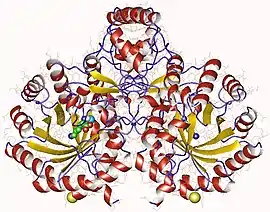Homocitrate synthase
In enzymology, a homocitrate synthase (EC 2.3.3.14) is an enzyme that catalyzes the chemical reaction
- acetyl-CoA + H2O + 2-oxoglutarate (R)-2-hydroxybutane-1,2,4-tricarboxylate + CoA
| homocitrate synthase | |||||||||
|---|---|---|---|---|---|---|---|---|---|
 Homocitrate synthase homodimer, Schizosaccharomyces pombe | |||||||||
| Identifiers | |||||||||
| EC no. | 2.3.3.14 | ||||||||
| CAS no. | 9075-60-9 | ||||||||
| Databases | |||||||||
| IntEnz | IntEnz view | ||||||||
| BRENDA | BRENDA entry | ||||||||
| ExPASy | NiceZyme view | ||||||||
| KEGG | KEGG entry | ||||||||
| MetaCyc | metabolic pathway | ||||||||
| PRIAM | profile | ||||||||
| PDB structures | RCSB PDB PDBe PDBsum | ||||||||
| Gene Ontology | AmiGO / QuickGO | ||||||||
| |||||||||
The 3 substrates of this enzyme are acetyl-CoA, H2O, and 2-oxoglutarate, whereas its two products are (R)-2-hydroxybutane-1,2,4-tricarboxylate and CoA.
This enzyme belongs to the family of transferases, specifically those acyltransferases that convert acyl groups into alkyl groups on transfer. The systematic name of this enzyme class is acetyl-CoA:2-oxoglutarate C-acetyltransferase (thioester-hydrolysing, carboxymethyl forming). Other names in common use include 2-hydroxybutane-1,2,4-tricarboxylate 2-oxoglutarate-lyase, (CoA-acetylating), acetyl-coenzyme A:2-ketoglutarate C-acetyl transferase, and homocitrate synthetase. This enzyme participates in lysine biosynthesis and pyruvate metabolism.
References
- Strassman M, Ceci LN (1964). "Enzymatic formation of homocitric acid, an intermediate in lysine biosynthesis". Biochem. Biophys. Res. Commun. 14 (3): 262–7. doi:10.1016/0006-291X(64)90446-2. PMID 5836514.
- H; Miyazaki, J; Kobashi, N; Nishiyama, M; Hoshino, T; Yamane, H (2002). "Characterization of bacterial homocitrate synthase involved in lysine biosynthesis". FEBS Lett. 522 (1–3): 35–40. doi:10.1016/S0014-5793(02)02877-6. PMID 12095615.
- Andi B, West AH, Cook PF (2004). "Kinetic mechanism of histidine-tagged homocitrate synthase from Saccharomyces cerevisiae". Biochemistry. 43 (37): 11790–5. doi:10.1021/bi048766p. PMID 15362863.